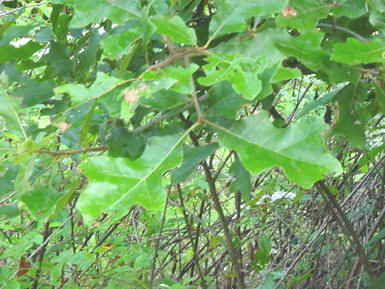Form: This tree is medium in size reaching 50 to 60 ft. in height and 2 to 3 ft. in dbh. It also has an irregular crown and a limby bole.
Leaves:
Arrangement: alternate
Shape: 5-7 bristle-tipped lobes; sun leaves have deep sinuses and shade leaves have very shallow sinuses
Margin: entire
Texture: thick; dark green and glabrous above; tomentose beneath
Venation: pinnate

Bark: The bark is thick, grayish-black in color and is deeply furrowed vertically with horizontal breaks. The inner bark is orange.
Twigs and buds: The twigs are brown in color, stout and glabrous. The buds are long and sharp with a grayish pubescence.
Flowers and fruit: The flowers are borne on catkins and are staminate. The fruit is an acorn that is long, ovid and 5/8 to 3/4 inches in length. The cap of the acorn has loose reddish-brown scales. It is also noted the the acorns mature in 2 years.
Distinguishing characteristics: This species has characteristic oak leaves, produced mast every 2 years, and has long terminal buds.
Range: This species occurs from Maine to Minnesota, south to eastern Texas and east to Florida.
Silvics: This species has an intermediate tolerance and occurs on mesic to dry uplands.
Ecological and cultural importance: The wood is sold as "red oak" and used for furniture and flooring. The acorns are eaten by a variety of mammals and birds. Notable species include: wild turkeys, squirrels, and white-tailed deer.